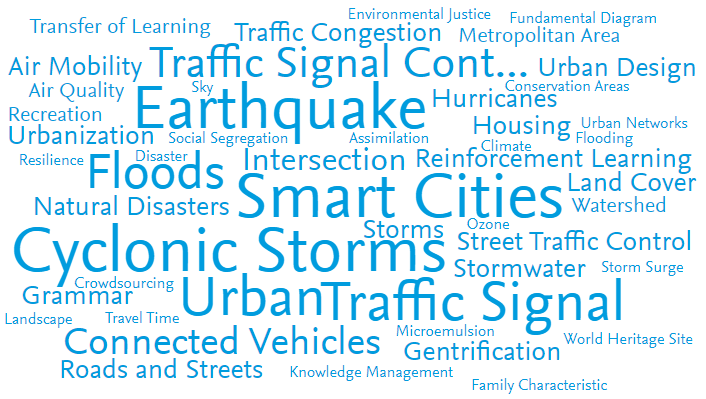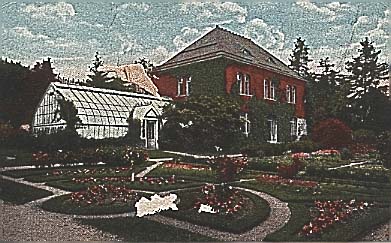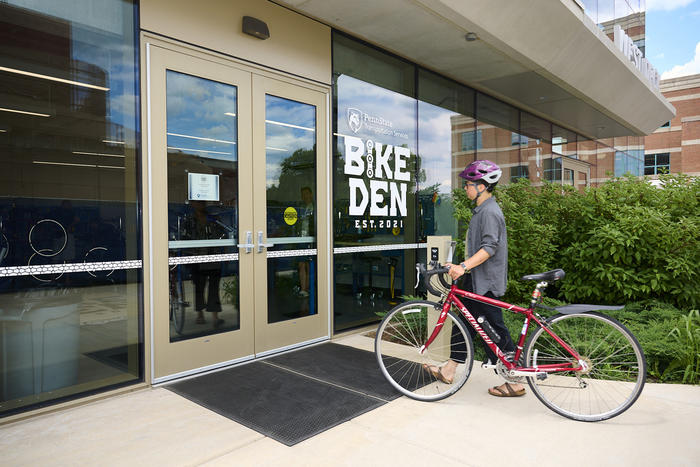
Make cities and human settlements inclusive, safe, resilient and sustainable
This goal is designed to be met by addressing individual, community, and regional needs. For example, targets include providing access for all to adequate, safe and affordable housing and basic services as well as safe, affordable, accessible and sustainable transport systems; enhancing inclusive and sustainable urbanization; protecting and safeguarding the world’s cultural and natural heritage; protecting the poor and people in vulnerable situations; reducing the adverse per capita environmental impact of cities; providing universal access to safe, inclusive and accessible, green and public spaces; strengthening national and regional development planning; and, adopting and implementing integrated policies and plans towards inclusion, resource efficiency, mitigation and adaptation to climate change, and resilience to disasters. See below for Penn State’s work on the targets and indicators for this goal.

Source: SciVal.com | This word cloud was created using publications from Penn State researchers
Related News
Board committee recommends selecting developer to build new student housing
UNIVERSITY PARK, Pa. — The Penn State Board of Trustees Committee on Finance and Investment voted Nov. 7 to move forward with a recommendation to the full board to select a developer to build a [...]
Explore new HUB Galleries exhibitions: ‘Reunion’ and ‘Unknown Forest’ this week
The HUB-Robeson Galleries exhibitions, "Reunion" by Cannupa Hanska Luger, and "Unknown Forest" by Avani Patel can be viewed in the HUB Gallery and Art Alley. All the works in this exhibition embody the celebration of [...]
Library exhibit showcases Penn State Mont Alto’s history as forestry school
Penn State Mont Alto has a rich history from its beginnings as the Pennsylvania State Forest Academy, one of the first public forestry schools in the nation. Visitors to the campus can experience that history up close [...]
Community-driven impact is at the heart of Penn State Center Philadelphia
Carly Pourzand’s first day as the director of community-driven impact at the Penn State Center Philadelphia in April was not her first day on the job. She has been deeply invested in Philadelphia communities for more than [...]
Penn State, Indian Institute of Science award joint research seed grants
Penn State and the Indian Institute of Science (IISc) have announced the awardees for the 2024-25 cycle of their collaboration program. These awardees comprise four joint projects that connect Penn State and IISc researchers. The [...]
Board committee recommends selecting developer to build new student housing
The Penn State Board of Trustees Committee on Finance and Investment voted on Nov. 7, 2024 to move forward with a recommendation to the full board to select a developer to build a 1,500-bed affordable [...]
Supporting Evidence
Yes, Penn State provides public access to buildings, monuments and natural heritage landscapes of cultural significance. It is the policy of the University to preserve an open access environment and all significant buildings are open to the public from 8 am to 5 pm.

The Old Botany building, pictured above, built in 1887 is the oldest building on campus whose exterior has not been altered over the years. It was designed by College Architect F. L. Olds in the “Richardsonian Romanesque” style he also used in Old Engineering and the Armory. The most notable features are the large semicircular window on the east facade, eyelid dormers and terra cotta ornamentation on the ridge of the roof. The building first housed botany laboratories and had greenhouses attached and a formal garden in front, laid out by students in 1861. The interior is considerably altered and today is used for administrative offices.
- Penn State landmarks that the public can access include the original Old Main building, front campus landscape, and the former Carnegie library building. More information about publicly accessible Penn State Landmarks can be found on this library Penn State Landmarks webpage.
- The H.O. Smith Botanic Gardens and all other parts of the Arboretum are open to the public without charge. The Arboretum is a University facility for study, research, reflection, and enjoyment.
- Shaver’s Creek Environmental Center provides free public access to an aviary, herpetarium, indoor bird-watching station, ponds, pollinator gardens, interpretive environmental learning, trails for hiking, spots for picnicking, and more.
Learn more about Penn State’s progress on the UN’s Sustainable Development Goals on the SDG Progress page HERE, and learn more about work on SDG 11 HERE.
Yes, Penn State provides public access to libraries that includes access to books and publications. All University libraries are open to the public.
Any resident of Pennsylvania can register to have an account to borrow from the library.
Pennsylvania residents are eligible to register for a Penn State Library Borrower Card that allows individuals to borrow up to 100 books, DVDs, CDs and more.
In addition to free public access the libraries also provide instructional sessions to visiting groups free of charge.
Learn more about Penn State’s progress on the UN’s Sustainable Development Goals on the SDG Progress page HERE, and learn more about work on SDG 11 HERE.
All University museums and cultural sites have free public access.
The University Park campus houses six museums and several art galleries.
- Palmer Museum of Art is open with free admission to the public Tuesday-Sunday and offers many free programs to the public each semester such as Guided Tours and Yoga.
- The All-Sports Museum is open to the public Tuesday -Sunday with a suggested donation of $3-5.
- The student union building, the HUB, has the Robeson Art Galleries. This centrally located building has artwork throughout and is always free and open to all.
Campuses across the Commonwealth also provide free access to museums, exhibition spaces, galleries, and works of art and artifacts.
Penn State Altoona
- The Misciagna Family Center for Performing Arts includes the Paul R. and Margery Wolf-Kuhn Theatre, and the McLanahan and Sheetz Art Galleries and the Titelman Study. The Misciagna Family Center for Performing Arts hosts cultural and performing art series and theater productions, as well as special events throughout the year. Gallery access is free and performances are both free and ticketed.
Penn State Harrisburg
- The Madlyn L. Hanes Library features an “Art Wall” for displaying art owned by the college and highlighting the creative works of students at Penn State Harrisburg.
- Collections include The Pennsylvania Center for Folklore, Holocaust and Genocide, and Women’s History.
Penn State Behrend
- The John M. Lilley Library has a student art show and gallery.
Penn State Abington
- The Art Gallery features exhibitions and events
Penn State Berks
- The Freyberger Gallery is located on the first floor of the Perkins Student Center and features a regular schedule of exhibits by artists from around the world.
Penn State Wilkes-Barre
- The Friedman Art Gallery displays the work of students, local artists, and private art collections.
Penn State New Kensington
- The Art Gallery contracts artists for monthly gallery exhibitions featuring multi-media works of local and regional artists.
Penn State Fayette, The Eberly Campus
- The Coal and Coke Heritage Center is centered on the bituminous coal and coke industries of southwestern Pennsylvania, with particular attention to the Connellsville Coke Region. Exhibits and display areas focus on three major themes: Coal, Coke, and Community.
Penn State Lehigh Valley
- The Ronald K De Long Gallery brings fine arts programming to the academic community and stimulates and awareness and appreciation for the visual arts.
- Community Gallery showcases the work of local high school, college art students, and community art clubs with displays that rotate approximately six times per year.
- The Penn State Lehigh Valley Art Collection exhibits art throughout the campus to celebrate the rich artistic culture of the Lehigh Valley.
University-wide Campus Arts Initiative supports public art indoors and outdoors on multiple campuses.
Learn more about Penn State’s progress on the UN’s Sustainable Development Goals on the SDG Progress page HERE, and learn more about work on SDG 11 HERE.
Yes, Penn State provides free public access to open spaces and green spaces.
All campuses are open to the public for access to open and green spaces. At University Park, there is a map that describes all the trees to help enjoy the natural environment. At all campuses, community members often use public green spaces for recreation, picnics, and other community activities. In addition to open and green spaces on our campuses:
- The Penn State Arboreta Network aims to inventory trees and plant life while sharing research and teaching resources in order to leverage the capabilities of the Commonwealth Campuses, faculty, and trees to serve as teaching, research and community resources. Started by seven campuses (Abington, Altoona, Behrend, Berks, Mont Alto, Schuylkill and University Park) the eventual goal is to create an arboretum at each of the University’s 24 campuses.
- Penn State manages Stone Valley Forest, approximately 8,000 acres of forestland, which are open to public use including hunting, fishing, and trapping of wildlife.
- The Arboretum at Penn State is free and open to the public and features a year long schedule of events and volunteer programs and promotes the 200 Acres, a new self-guided touring app, which tests users’ knowledge of Penn State by providing new perspectives on the University’s original land, history, and purpose.
- Shavers Creek Environmental Center provide free public access to trails and open spaces as well as educational and recreational opportunities.
- Musser Gap is university property that provides free access to open space and serves as an important connection between State College and Rothrock State Forest. It provides a space for learning, stewardship, respite and connection. After two years of intensive student, faculty, and community work led by the PSU Department of Landscape Architecture with support from ClearWater Conservancy, including site analysis, community engagement, and design development, the PSU Office of Physical Plant (OPP) and Penn State Outreach teams developed a plan to support these efforts.
Learn more about Penn State’s progress on the UN’s Sustainable Development Goals on the SDG Progress page HERE, and learn more about work on SDG 11 HERE.
Yes, Penn State contributes to local arts by hosting free and paid concerts and public performances across our campuses. These performances are open to the public.
On the University Park (main) campus, the reports and projects page for the Center for The Performing Arts at University Park lists more than dozens of performances throughout each year (many of which were performed on multiple occasions). The Center for The Performing Arts is only one of several entities around the campuses providing performances for the community. An example of an annual event open to campus and community is the Penn’s Woods Music Festival.
On other Penn State campuses, there are vibrant arts programs that are open to the public.
Contributions to the local art performances on Penn State campuses include:
- Penn State Abington Performing Arts Center
- Penn State York’s Pullo Family Performaing Arts Center
- The Black Box Theatre in the Slusser/Bayzick Building at Penn State Hazleton
- Penn State Harrisburg’s Mukund S. Kulkarni Theater
- An array of creative events open to the community at Penn State DuBois
- Theater productions at Penn State Behrend
- Penn State Altoona’s performing arts programs
Contributions to local art through free access to galleries and exhibits include:
- The Friedman Art Gallery at Penn State Wilkes-Barre
- Penn State Scranton’s campus sculpture gallery
- The Ronald K DeLong Gallery at Penn State Lehigh Valley
- Penn State New Kensington’s Art Gallery
- The Art Gallery at Penn State Abington
Learn more about Penn State’s progress on the UN’s Sustainable Development Goals on the SDG Progress page HERE, and learn more about work on SDG 11 HERE.
Yes, Penn State Libraries deliver projects to record and/or preserve intangible cultural heritage such as local folklore, traditions, language, and knowledge.
The university is home to a wide array of collections and initiatives dedicated to preserving intangible cultural heritage across diverse communities, identities, and historical contexts. This work supports the UN Sustainable Development Goal of safeguarding heritage, as Penn State curates collections that reflect a broad spectrum of human experience, with a focus on inclusivity.
The Literary and Cultural Heritage Maps of Pennsylvania project, part of The Pennsylvania Center for the Book located in the Paterno Library at University Park, is a digital humanities initiative dedicated to showcasing Pennsylvania’s literary and cultural legacy. This project emphasizes representation from all demographic groups and geographic regions within Pennsylvania, with a priority on marginalized and underrepresented communities, including women, Black, Indigenous, People of Color, LGBTQ+ individuals, and people with disabilities.
Penn State Libraries also participate in PA Digital, Pennsylvania’s hub for the Digital Public Library of America. Through this partnership, Penn State contributes collections that document pivotal moments in history,
such as “The Fight for Suffrage,” the Battle of Gettysburg, WWII, and the history of railroads and Quaker influence in Pennsylvania. Penn State scholars engage actively in discussions around Inclusive Archives and Digital Preservation to enhance access to cultural materials.
The Center for Black Digital Research in the College of the Liberal Arts is a public-facing research center focused on bringing the histories of early Black organizing to digital life through cutting-edge scholarship and community partnerships. Additionally, University Libraries host a variety of Digital Projects and Exhibits, including Black Representation in American Politics, The Legacy and Evolution of Disability Rights, and the Latino/a/x Experience Oral History Project.
In addition to these projects, Penn State Libraries maintain specialized collections that highlight diverse historical narratives:
- Charles L. Blockson Collection of African-Americana and the African Diaspora: A treasure trove of materials documenting African-American history and culture, from slavery to civil rights, and significant cultural figures.
- Holocaust and Genocide Collection: Over 70 oral histories from Holocaust survivors, liberators, and witnesses in the Harrisburg area, preserving personal testimonies of profound historical events.
- PA Center for Folklore Collection: Home to the Mac Barrick Collection of Folklife and Regional History, which includes manuscripts, recordings, and documents on Pennsylvania folklore and local history, supporting the Pennsylvania Center for Folklore.
- Alice Marshall Women’s History Collection: Documents the evolution of women’s rights, feminism, and gender roles, with materials from the 15th to the 20th centuries.
- Women’s Suffrage Collection: A primary resource for understanding the U.S. women’s suffrage movement, containing original pamphlets, broadsides, and memorabilia.
- Pennsylvania German Broadsides and Fraktur Collection: Showcasing decorated manuscripts and historical prints from Pennsylvania German communities, this collection preserves unique expressions of cultural heritage, from folk art to religious beliefs.
- Unearthing the Past: Student Research on Pennsylvania History: Highlights student contributions to uncovering local historical narratives, supporting engagement with Pennsylvania’s heritage.
- Black History and Visual Culture Collection: Provides insight into African American life and visual culture through rare books, newspapers, and photography, deepening understanding of Black heritage.
- Gender and Sexual Identity and Expression Collection: A comprehensive archive exploring LGBTQ+ history and social activism, supporting research into gender and sexuality across historical contexts.
Library guides such as Indigenous Peoples of Pennsylvania and Folklore and Folklife Studies further support Penn State’s commitment to preserving intangible cultural heritage and facilitating public access to these resources. The Center for Holocaust and Jewish Studies at Penn State Harrisburg continues this mission, offering events, lectures, and access to educational materials on Holocaust remembrance and Jewish cultural studies.
Learn more about Penn State’s progress on the UN’s Sustainable Development Goals on the SDG Progress page, and discover work on SDG 11 to promote sustainable cities and communities.
Yes, Penn State measures sustainable commuting by tracking the number of parking permits issued, the number of bicycles registered, and the number of campus bus rides and shuttle rides taken each semester and year.
The Transportation Dashboard provides data on the total fleet vehicles by fuel type and a breakdown of commute modes for faculty, staff, and students.
Sustainable commuting is also tracked using the Commute Modal Split section of the STARS report which reflects percentage of students that use more sustainable commuting options as their primary mode of transportation. The STARS report also measures Support for Sustainable Transportation which guides target setting for bike and car sharing programs, EV charging stations, and fuel efficient vehicles.
The University works to support more sustainable commuting to and visiting our campuses by providing ride share options, EV charging stations, encouraging bicycling and the use of public transportation.
Learn more about Penn State’s progress on the UN’s Sustainable Development Goals on the SDG Progress page HERE, and learn more about work on SDG 11 HERE.
Yes, Penn State undertakes actions to promote a greater percentage of sustainable commuting. The university promotes sustainable commuting through a number of programs. These include: free bus rides on the Loop, Link, and Campus Shuttle routes; access to reduced-fare bus service to/from campus for eligible Penn State full-time employees and graduate students; nearly 800 bike racks; a bike repair and bike maintenance facility on campus (pictured below); bicycle repair stations across campus; a Ride Smart program which provides students with 8, $10 credits to use lyft rides; supports 300 electric assist bikeshare bikes; and provides several electric vehicle charging stations on campus.

The Bike Den, a bike repair and bike maintenance facility on the University Park campus
Penn State Transportation services hosts an informative website on bicycling, bike repair, and bus and shuttle services.
We are a gold level certified bicycle friendly university.
Learn more about Penn State’s progress on the UN’s Sustainable Development Goals on the SDG Progress page HERE, and learn more about work on SDG 11 HERE.
Yes, the university promotes and allows remote work/telecommuting as a standard practice and has a policy on Staff Flexible Work Arrangements. Accelerated by the pandemic, Penn State employees have a vast scope of remote and hybrid options.
Considerations for flexible work arrangements and details on compliance requirements, modification and discontinuation of arrangements, employee benefits, University policies, and insurance coverage are available in Policy HR107.
Prior to the pandemic, Penn State did offer telecommuting options however these options have been expanded and continue to evolve by recommendations drafted by the Remote Work Task Force. This policy and practice has greatly reduced the need for commuting.
Learn more about Penn State’s progress on the UN’s Sustainable Development Goals on the SDG Progress page HERE, and learn more about work on SDG 11 HERE.
Penn State provides discounts for employees to offset costs associated with moving and relocation and for financial and real estate services to help employees find housing within their budgets, and subsidized commuting options for employees who choose to live in outlying communities. For some staff positions, the University offers free housing on campus at no cost to staff, such as residence life coordinators and visiting faculty.
Learn more about Penn State’s progress on the UN’s Sustainable Development Goals on the SDG Progress page HERE, and learn more about work on SDG 11 HERE.
Yes, Penn State does provide a range affordable housing for students. There are a vast scope of on-campus housing options, and resources to help students find off-campus housing within their budget.
On November 7, 2024, the University announced plans to build a 1,500-bed affordable housing development to meet the needs of students attending the University Park campus.
For students in crisis or in need of financial assistance, the University has a generous Student Emergency Fund. Funds are typically used to address acute financial stress, covering rent or temporary housing, along with other essential needs.
96% of Pennsylvanians live within 30 miles of a Penn State location providing the opportunity for Pennsylvania students to remain in their home communities.
Learn more about Penn State’s progress on the UN’s Sustainable Development Goals on the SDG Progress page HERE, and learn more about work on SDG 11 HERE.
Yes, the Penn State University Park campus has prioritized pedestrian access to campus by adopting a road closure policy in 2018. It is still active for cars traveling on a main thoroughfare on campus as part of campus master plan to reestablish pedestrian zones. Additionally, a Safe Walk Program has been established to promote campus safety and pedestrian walkability at night.
All 20 Commonwealth campuses keep parking on the periphery with a majority of routes on the body of campus as walk only paths.
Campus maps of all campuses show numerous pedestrian-only walkways.
Learn more about Penn State’s progress on the UN’s Sustainable Development Goals on the SDG Progress page HERE, and learn more about work on SDG 11 HERE.
Yes, the university works with local authorities within which all campuses operate. An example of this is Penn State’s Pennsylvania Housing Research Center (PHRC) provides and facilitates education, training, innovation, research, and dissemination to the residential construction industry for the purpose of improving the quality and affordability of housing. The PHRC collaboratively engages with the residential construction industry to catalyze advancements in home building and addresses a range of topics relevant to the home building industry to reach a diverse audience: builders, code officials, remodelers, architects, developers, engineers, planners, landscape architects, local government officials, educators, etc. to provide professional development and continuing education.
Additionally, Penn State partners with the State College Community Land Trust through PHRC and the Hamer Center for Community Design to support and advance affordable housing for local residents.
Learn more about Penn State’s progress on the UN’s Sustainable Development Goals on the SDG Progress page HERE, and learn more about work on SDG 11 HERE.
Yes, the university does build new buildings to sustainable standards. It is a requirement at Penn State to build all new buildings to LEED standards as described in the 2019 LEED v4 policy.
Penn State is a world leader in sustainable building design and standards with 48 buildings that are, at minimum, LEED certified, with an additional 19 pending certification. In 2021, Penn State began building the new Palmer Art Museum of Art to US Green Building Council standards for Leadership in Energy and Environmental Design (LEED) certification.
Learn more about Penn State’s progress on the UN’s Sustainable Development Goals on the SDG Progress page HERE, and learn more about work on SDG 11 HERE.
Yes, Penn State builds on brownfield sites, where possible. As outlined in the new Capital Plan, campus building projects are focused on prior plan renovation and re-building, which is considered brownfield building based on global standards, and on system renewals on existing sites.
Recent examples of brownfield construction:
- Susan Welch Liberal Arts Building is using an innovative design that takes into account site constraints — such as zoning height restrictions, mature tree locations, connections to existing sidewalk networks and service needs — along with the desire for a cohesive design with adjacent buildings.
- A renovation of the East Hall residential halls took place instead of building in a new location.
- Animal, Veterinary and Biomedical Sciences Building built on site of former Henning Building
- Chemical and Biomedical Engineering Building built on the site of former Fenske Laboratory
Learn more about Penn State’s progress on the UN’s Sustainable Development Goals on the SDG Progress page HERE, and learn more about work on SDG 11 HERE.
Targets & Indicators
Target 11.1: By 2030, ensure access for all to adequate, safe and affordable housing and basic services and upgrade slums
- Indicator 11.1.1: Proportion of urban population living in slums, informal settlements or inadequate housing
Target 11.2: By 2030, provide access to safe, affordable, accessible and sustainable transport systems for all, improving road safety, notably by expanding public transport, with special attention to the needs of those in vulnerable situations, women, children, persons with disabilities and older persons
- Indicator 11.2.1: Proportion of population that has convenient access to public transport, by sex, age and persons with disabilities
Target 11.3: By 2030, enhance inclusive and sustainable urbanization and capacity for participatory, integrated and sustainable human settlement planning and management in all countries
- Indicator 11.3.1: Ratio of land consumption rate to population growth rate
- Indicator 11.3.2: Proportion of cities with a direct participation structure of civil society in urban planning and management that operate regularly and democratically
Target 11.4: Strengthen efforts to protect and safeguard the world’s cultural and natural heritage
- Indicator 11.4.1: Total per capita expenditure on the preservation, protection and conservation of all cultural and natural heritage, by source of funding (public, private), type of heritage (cultural, natural) and level of government (national, regional, and local/municipal)
Target 11.5: By 2030, significantly reduce the number of deaths and the number of people affected and substantially decrease the direct economic losses relative to global gross domestic product caused by disasters, including water-related disasters, with a focus on protecting the poor and people in vulnerable situations
- Indicator 11.5.1: Number of deaths, missing persons and directly affected persons attributed to disasters per 100,000 population
- Indicator 11.5.2: Direct economic loss attributed to disasters in relation to global gross domestic product (GDP)
- Indicator 11.5.3: (a) Damage to critical infrastructure and (b) number of disruptions to basic services, attributed to disasters
Target 11.6: By 2030, reduce the adverse per capita environmental impact of cities, including by paying special attention to air quality and municipal and other waste management
- Indicator 11.6.1: Proportion of municipal solid waste collected and managed in controlled facilities out of total municipal waste generated, by cities
- Indicator 11.6.2: Annual mean levels of fine particulate matter (e.g. PM2.5 and PM10) in cities (population weighted)
Target 11.7: By 2030, provide universal access to safe, inclusive and accessible, green and public spaces, in particular for women and children, older persons and persons with disabilities
- Indicator 11.7.1: Average share of the built-up area of cities that is open space for public use for all, by sex, age and persons with disabilities See metadata :
- Indicator 11.7.2: Proportion of persons victim of physical or sexual harassment, by sex, age, disability status and place of occurrence, in the previous 12 months
Target 11.a: Support positive economic, social and environmental links between urban, peri-urban and rural areas by strengthening national and regional development planning
- Indicator 11.a.1: Number of countries that have national urban policies or regional development plans that (a) respond to population dynamics; (b) ensure balanced territorial development; and (c) increase local fiscal space
Target 11.b: By 2020, substantially increase the number of cities and human settlements adopting and implementing integrated policies and plans towards inclusion, resource efficiency, mitigation and adaptation to climate change, resilience to disasters, and develop and implement, in line with the Sendai Framework for Disaster Risk Reduction 2015–2030, holistic disaster risk management at all levels
- Indicator 11.b.1: Number of countries that adopt and implement national disaster risk reduction strategies in line with the Sendai Framework for Disaster Risk Reduction 2015–2030
- Indicator 11.b.2: Proportion of local governments that adopt and implement local disaster risk reduction strategies in line with national disaster risk reduction strategies
Target 11.c: Support least developed countries, including through financial and technical assistance, in building sustainable and resilient buildings utilizing local materials







